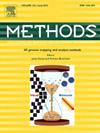Michaelis-Menten kinetics of RasGAP proteins by a rapid fluorescence-based assay
IF 4.3
3区 生物学
Q1 BIOCHEMICAL RESEARCH METHODS
引用次数: 0
Abstract
Ras small GTPases are essential for a wide range of cellular processes. These proteins cycle between the GDP-loaded and GTP-loaded states, and the actions of GTPase activating proteins (GAPs) are necessary to stimulate Ras-mediated GTP hydrolysis. Here, we provide a protocol to achieve Michaelis-Menten kinetic profiling of GAP-mediated stimulation of a small GTPase by real-time monitoring of inorganic phosphate release in vitro. This is achieved using fluorescence of the Phosphate Sensor protein, an MDCC conjugate with periplasmic phosphate binding protein (PstS). We use H-Ras small GTPase pre-loaded with GTP and its stimulation by p120RasGAP (RasGAP, RASA1) as an example of this protocol. We discuss protocol design, assay development, data collection, processing, and analysis. Typical assays comprise up to twenty simultaneous reactions with phosphate production rates on the order of tens of nM/s. We also provide guidelines for the optimization of reagent conditions, particularly salt concentrations, and assess their functional impact. The described protocol provides a convenient and comprehensive method to achieve accurate monitoring of small GTPase activation by GAP proteins using widely available materials and suitable to a range of applications.
RasGAP蛋白的Michaelis-Menten动力学
Ras小gtpase对广泛的细胞过程至关重要。这些蛋白在GTP加载和GTP加载状态之间循环,GTP酶激活蛋白(gap)的作用是刺激ras介导的GTP水解所必需的。在这里,我们提供了一种方案,通过实时监测体外无机磷酸盐释放来实现gap介导的小GTPase刺激的Michaelis-Menten动力学分析。这是通过磷酸传感器蛋白的荧光来实现的,磷酸传感器蛋白是一种MDCC结合质周磷酸结合蛋白(PstS)。我们使用预加载GTP的H-Ras小GTPase并通过p120RasGAP (RasGAP, RASA1)刺激其作为该方案的示例。我们将讨论方案设计、试验开发、数据收集、处理和分析。典型的测定包括多达20个同时发生的反应,磷酸盐的生产速度为几十nM/s。我们还提供了优化试剂条件的指导方针,特别是盐浓度,并评估其功能影响。所描述的协议提供了一个方便和全面的方法来实现精确监测小GTPase激活的GAP蛋白使用广泛可用的材料和适用于广泛的应用。
本文章由计算机程序翻译,如有差异,请以英文原文为准。
求助全文
约1分钟内获得全文
求助全文
来源期刊

Methods
生物-生化研究方法
CiteScore
9.80
自引率
2.10%
发文量
222
审稿时长
11.3 weeks
期刊介绍:
Methods focuses on rapidly developing techniques in the experimental biological and medical sciences.
Each topical issue, organized by a guest editor who is an expert in the area covered, consists solely of invited quality articles by specialist authors, many of them reviews. Issues are devoted to specific technical approaches with emphasis on clear detailed descriptions of protocols that allow them to be reproduced easily. The background information provided enables researchers to understand the principles underlying the methods; other helpful sections include comparisons of alternative methods giving the advantages and disadvantages of particular methods, guidance on avoiding potential pitfalls, and suggestions for troubleshooting.
 求助内容:
求助内容: 应助结果提醒方式:
应助结果提醒方式:


